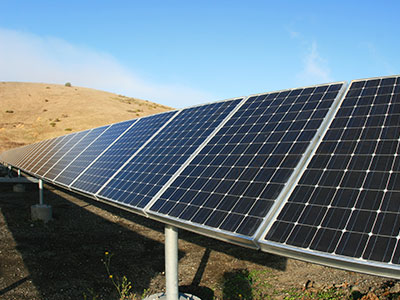Trade in Clean Energy
Bridging the Governance Gap
Christopher Dent and Clare Richardson-Barlow (University of Leeds) discuss the need for comprehensive governance of trade in clean energy and highlight the potential of cooperation between WTO and the UNFCCC to better utilize clean energy trade to achieve climate goals.
In 2015, roughly 74% of the world’s electricity came from fossil fuels and only 24% from renewables. [1] While clean energy technologies—including wind, solar, hydropower, bioenergy, geothermal, and ocean energy technologies—can play a vital role in international efforts to address climate change, systemic changes are necessary to reshape current energy mixes.
Clean energy trade offers a unique, economically oriented policy solution to global climate challenges and will facilitate the greater deployment of clean energy technologies. Increased trade in clean energy technologies will allow companies to expand production capacity and further open up clean energy markets to healthy economic competition. It could also bring about further innovation and technology advances. In particular, for the Asia-Pacific—a substantial contributor to global carbon dioxide emissions as well as a leader in technology innovation and manufacturing in clean energy industries—these industries provide long-term, often high-tech development opportunities to national economies, while also playing an important part in national green growth strategies.
But with increased trade volumes comes the potential for increased conflict. Due to its global coverage, record of successful trade facilitation, and role as arbitrator of trade disputes, the World Trade Organization (WTO) offers the best framework within which to strengthen global trade and climate governance; yet important improvements must be made to achieve these goals. First, the WTO should work to combine its traditional trade agenda with new rules that create greater policy space for trade-climate capacity building. Additionally, it should increase cooperation with the United Nations Framework Convention on Climate Change (UNFCCC) in order to reconcile the challenges that liberal trade and economic policies pose to global climate goals. These recommendations are discussed in greater detail in the following sections.
The WTO and Clean Energy Trade
The WTO currently has no energy-specific trade disciplines and thus only addresses clean energy with its generic rules. To date, these have been applied mainly against industrial policy measures alleged to confer an unfair trade advantage to protagonist states. Within this context, the WTO’s dispute-settlement mechanism has been increasingly invoked to resolve trade disputes on clean energy, and almost 50 cases of unilateral trade remedy action (e.g., countervailing duties) have been undertaken in this sector since the late 2000s.
Members are permitted under Article XX to adopt “WTO inconsistent” measures if deemed necessary for the protection of human, animal, or plant life; on health grounds; or in the interests of environmental conservation. However, this applies only to environmental policy measures, where a balancing test between environmental welfare benefits and trade welfare costs is performed. Industrial policy measures are treated under WTO rules on subsidies, price dumping, and local content requirements, where no such mechanism exists under current regulations to account for the environmental benefits of clean energy and other green industries.
Over the years, developments under the WTO framework have yielded some progress toward regulating clean energy trade. Clean energy was a core element of talks at the Doha Development Round in 2001, during which the WTO Committee on Trade and Environment oversaw negotiations on a trade liberalization agreement for environmental goods and services. However, progress was hindered by disagreements over product classification issues and by Doha Round inertia.
New impetus on this front was provided by an Asia-Pacific Economic Cooperation (APEC) initiative launched in 2011 to liberalize trade through an environmental goods agreement (EGA). The agreement was subsumed into the WTO process in 2014 and provided a much-needed boost to stalled discussions. Today, EGA talks are ongoing with 44 countries from the Asia-Pacific and Europe, accounting for an estimated 86% of globally traded environmental goods. [2] Despite having completed thirteen rounds of talks as of May, however, negotiating parties had not settled on the final list of clean energy and other environmental goods due to issues over unresolved product classification as well as other outstanding issues such as China’s call for special and differential treatment for developing countries regarding tariff adjustment. [3]
Ultimately, a finalized EGA would establish a core consensus on clean energy product classification and thereby help define boundaries for clean energy trade. However, this would not be a complete solution, as the WTO would still have trade rules with no explicit links to climate action.
Crafting a Role for the UNFCCC
The UNFCCC could provide a much-needed link between trade rules and climate change mitigation, but thus far it has not filled this potential role. Established in 1992, the UNFCCC is a treaty-based governance framework endeavoring to coordinate national-level climate actions and is a much younger and weaker governance structure than the WTO.
The UNFCCC has no rules-based system, and the 1997 Kyoto Protocol largely failed to achieve its goals for reducing carbon emissions. However, the Paris Agreement from December 2015—the largest global climate agreement in history, bringing together 195 countries and setting agreed-upon targets for reducing greenhouse gas emissions as a means to address changes to the global climate—could prove a landmark deal on decarbonization if it is successfully ratified. To meet its goal of limiting global temperature increases to 1.5 degrees Celsius above pre-industrial levels, the Paris Agreement will necessitate governments worldwide to ramp up clean energy development. Yet somewhat surprisingly the text of the agreement does not mention trade, despite twenty years of WTO-UNFCCC inter-institutional dialogue. Trade is a defining feature of the global economy and thus quite relevant to discussions on low-carbon development.
Policy Implications
Economic, technology development, and industrial policy incentives will continue to make clean energy an attractive industry for growth in the Asia-Pacific, and global leaders from the region will continue to design and produce competitive energy solutions. In tandem with these trends, public and private investment in clean energy industries will also likely continue to expand fast, especially if the Paris Agreement comes into force. This will lead to further incentives for and growth in the volume of clean energy trade, and consequently will yield additional trade disputes. Given the limitations of the WTO and UNFCCC, clean energy trade is facing a significant gap in global governance, and action is needed to rectify this problem.
A broad-ranging EGA combining trade liberalization with new WTO rules would create greater policy space for action on trade-climate capacity building, especially in developing countries. For example, maximum time periods and stricter conditions of use could apply to trade remedy measures on clean energy or environmental goods more widely. Although governments may not be ready to address the challenges of balancing economic development with climate change, multilateral institutions like the WTO can play a role in bringing this contradiction to the forefront of global politics. A broad-ranging EGA could be an important first step forward in reconciling interventionist climate action with an essentially liberal trade order.
To date, the UNFCCC is unable to bear the burden of facilitating and arbitrating clean energy trade, nor was it created to do so. The UNFCCC’s weaker governance structure, lack of trade-based initiatives, and ratification requirements make the WTO a better choice for improving governance of clean energy trade. Nonetheless, increased cooperation between the WTO and UNFCCC would go a long way in reconciling the challenges that liberal trade and economic policies pose to global climate goals.
Endnotes
[1] Renewable Energy Policy Network for the 21st Century (REN21), Renewables 2016 Global Status Report (Paris: REN21, 2016), http://www.ren21.net/wp-content/uploads/2016/06/GSR_2016_Full_Report1.pdf.
[2] Ricardo Meléndez-Ortiz, “Enabling the Energy Transition and Scale-Up of Clean Energy Technologies: Options for the Global Trade System,” International Centre for Trade and Sustainable Development and World Economic Forum, Policy Options Paper, January 2016.
[3] “Environmental Goods Agreement Negotiators Discuss Tariff Cut Offers,” Bridges, April 27, 2016, http://www.ictsd.org/bridges-news/bridges/news/environmental-goods-agreement-negotiators-discuss-tariff-cut-offers.
Christopher Dent is a Professor of East Asia’s International Political Economy at the University of Leeds. Clare Richardson-Barlow is a Postgraduate Research Student in the Department of East Asian Studies at the University of Leeds.



